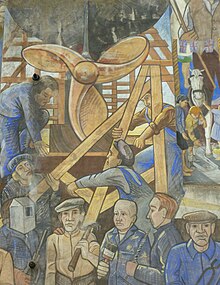Henry Robb
 |
|
| Public | |
| Industry | Shipbuilding |
| Fate | Closed |
| Founded | 1918 |
| Defunct | 1983 |
| Headquarters | Leith, Edinburgh, Scotland |
|
Key people
|
Henry Robb |
Henry Robb, Limited, known colloquially as Robbs, was a Scottish shipbuilding company based at Leith Docks in Edinburgh. Robbs was notable for building small-to-medium sized vessels, particularly tugs and dredgers.
The company was founded on 1 April 1918 by Henry Robb, a former yard manager for Ramage and Ferguson.
Robbs grew by buying berths from Hawthorns in 1924, the business of Cran and Somerville in 1926 and the yards of Ramage and Ferguson in 1934. The site became known as Victoria Shipyard.
Robbs closed its Arbroath and Clyde operations in the 1920s and focused its activities on Leith.
During World War II, Robbs built a large number of naval warships for the Royal Navy, including preparing the designs and building the prototype of the Basset-class anti-submarine / minesweeping trawler. Three Bird-class Corvettes were built for the Royal New Zealand Navy. Ordered in 1939, two of these ships would famously sink the Japanese submarine I-1 in January 1943.
On 26 February 1940 King George VI and Queen Elizabeth toured the shipyard.
In 1968 Robbs merged with the Caledon Shipbuilding & Engineering Company of Dundee, forming Robb Caledon Shipbuilding, and in 1969 the new company took over the Burntisland Shipbuilding Company in Fife. In 1977, under the provisions of the Aircraft and Shipbuilding Industries Act 1977, Robb Caledon was nationalised as part of British Shipbuilders. The Caledon yard in Dundee closed in 1981. Robb's yard in Leith survived two more years, closing in 1983.
...
Wikipedia
